US B-2 Spirit strategic bombers and around 200 soldiers are currently deployed at Keflavìk Air Station, Iceland. The base serves as a starting point for the three aircraft’ co-training with Northern European allies.
Last Tuesday, General James B. Hecker, Commander of the US Air Forces in Europe and NATO’s Air Command, also came to Iceland.
He had a meeting with the Icelandic MFA Thórdís Kolbrún Reykfjörd Gylfadóttir about the Ukraine War, NATO’s strengthened deterrence and defense – and ICeland’s contribution as a country without its own armed forces.
“We discussed the evolving security situation and how NATO is adapting, particularly within air defense and air surveillance. Iceland contributes to the security of the Alliance by operating the Radar and Communications sites that play an important role in maintaining situational awareness in the skies above the North Atlantic,” says Gylfadóttir in a press release.
General Hecker also visited the allied radar station at Bolafjall and the American soldiers at Keflavìk.
“It has been valuable to see the extent of NATO infrastructure that is operated by Iceland, which forms an important contribution to air domain situational awareness in a strategically important region. I have also had the pleasure of visiting the B2 Bomber. We are grateful to our Icelandic partners for enabling this deployment and to the professional Icelandic Coast Guard that provides host nation support in Keflavik.”
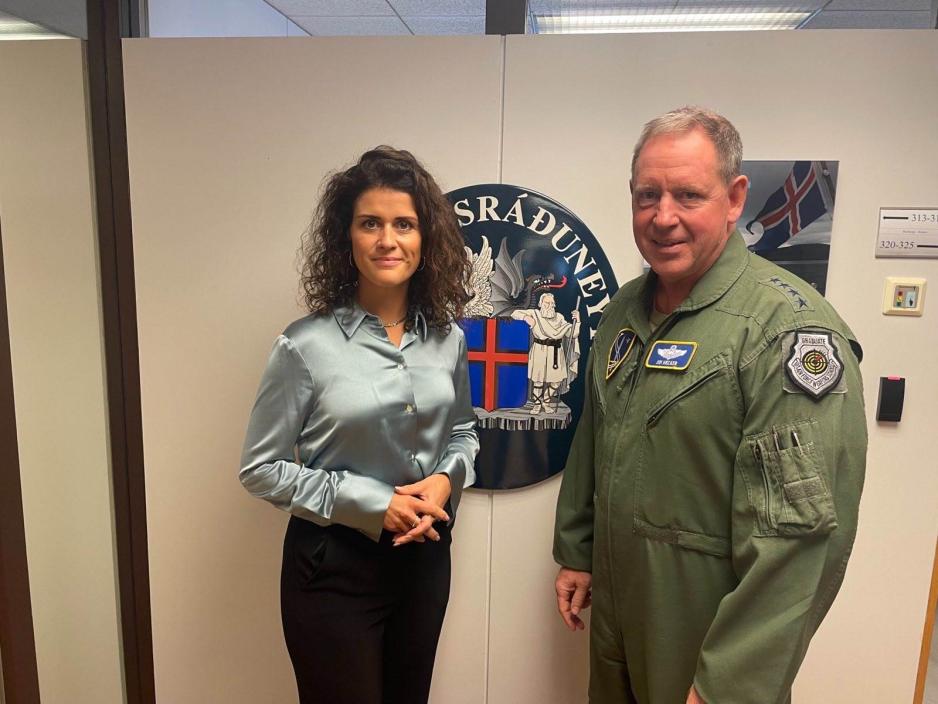
The bomb force’s mission
The American force in Iceland is solving a Bomber Task Force Mission (BTF) for strategic deterrence in the High North.
“Across the globe, U.S. Strategic Command routinely orchestrates BTF operations to not only showcase the United States’ commitment to collective defense but also to seamlessly integrate with operations conducted by [various, ed. note] America’s Geographic Combatant Commands,” informs the US Air Forces in Europe (USAFE).
The specific mission is under the US European Command (USEUCOM). Reportedly, this was designed to bolster this command’s “overarching security mandates across the European continent” – as well as affording aircrews the opportunity to acclimate themselves to the challenges of joint and coalition operations in foreign locations.
“Each bomber task force mission underscores the prowess of our armed forces in navigating today’s intricate and unpredictable global security terrain, with a focus on fostering stability, security, and freedom across Europe,” states Hecker.
He also points to the US’ “unwavering cooperation” with European allies and partners to thwart possible challenges against their sovereignty.
B-2 Spirit bombers
– The B-2 Spirit is an American intercontinental strategic bomber with massive firepower. It can carry up to 18 tonnes of weapons – also nuclear munitions.
– The aircraft was developed by Northrop Grumman Corporation in the 1980s and delivered to the US Air Force as of 1993. It was first used in combat in 1999 during NATO’s air operation in Kosovo.
– The B-2 is a four-engine jet-powered bomber designed as a flying wing with several stealth features. Stealth refers to military equipment designed to be difficult for an adversary to detect.
– The aircraft’s range is 9,600 kilometers without refueling.
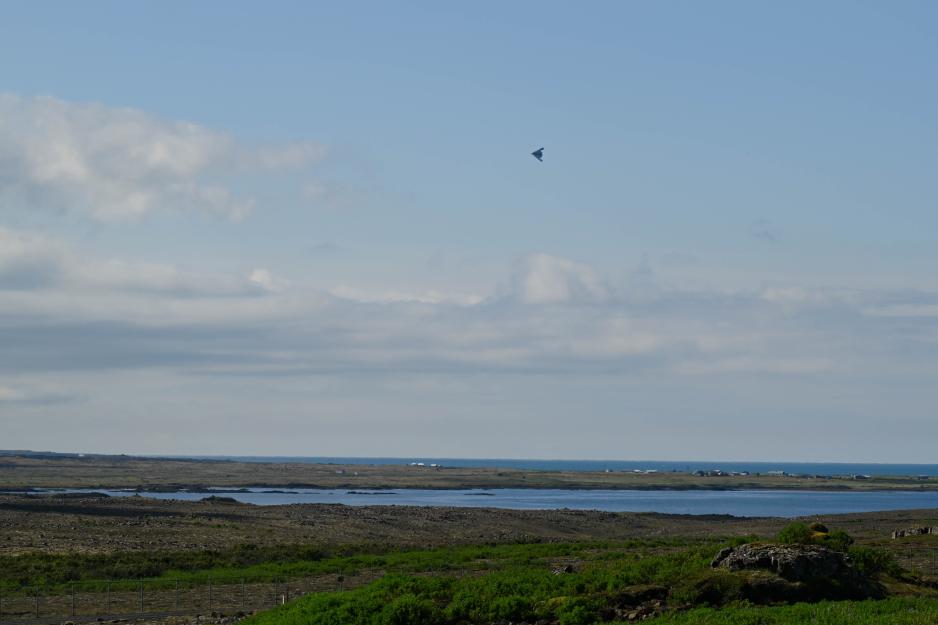
The B-2 is the most feared and respected weapon system. The world watches when we deploy.Lt. Col. Stephen Bressett, director of operations of the 393rd Bomb Squadron
Unpredictability
Faced with the problem of simultaneity – having to be militarily present both in Europe, Asia, and other parts of the world – the US has adopted a more unpredictable pattern of operations to deter its adversaries.
From the American side, operational flexibility or unpredictability is highlighted when referring to the bomb force mission which is currently being solved from Keflavìk.
“The B-2 bomber is arguably the most strategically significant airplane in the world, but that doesn’t mean it’s inflexible; dynamically deploying the bombers forward is a unique and important capability,” says Lt. Col. Andrew Kousgaard, the commander of 393rd Bomb Squadron, which is now operating on Iceland.
‘Agile strength training’
In this case, a mobile operational center and a concept for Agile Combat Employment (ACE) is utilized.
“ACE addresses today’s changing threat environment, instead of treating overseas bases as sanctuaries, it shifts the generation of strategic airpower to networks of small bases and dispersed locations,” informs the Whiteman Air Station in Missouri, home base of the B-2 aircraft in question.
“We remain strategically predictable – ready to answer our security commitments globally – while also being operationally unpredictable and flexing our ability to employ global strike from anywhere, anytime. This BTF allows us to exercise those muscles,” adds Lt. Col. Stephen Bressett, director of operations of the 393rd Bomb Squadron.
It can also be mentioned that the Icelandic government in April gave permission for US nuclear submarines to make short service visits to Iceland.
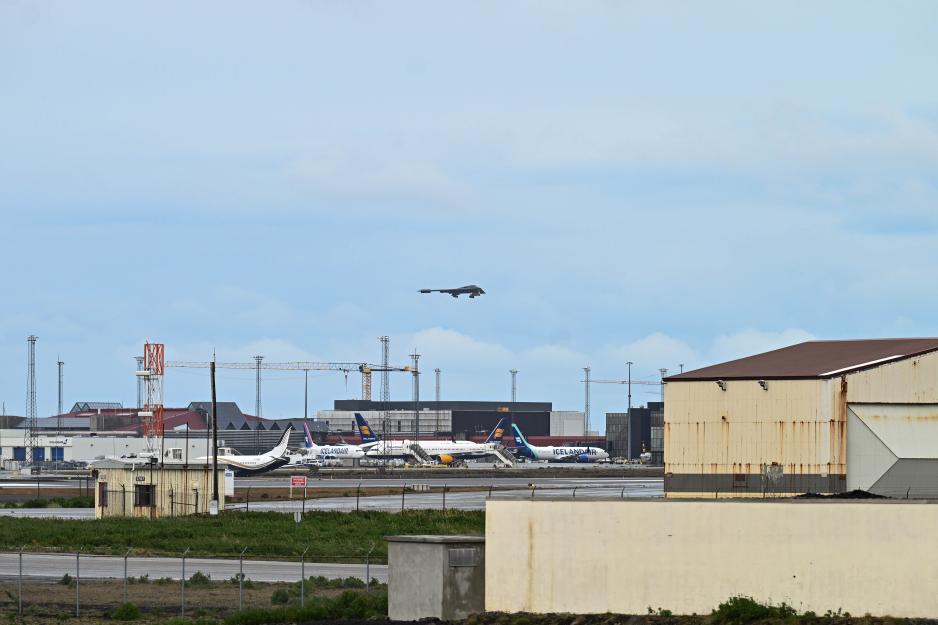
Historic visit to Norway
Norway is among the allied countries with which the American bombers train during their stay in Iceland, which lasts a couple of weeks in total.
On Tuesday last week – after co-training with Norwegian F-35 fighters and the Army – B-2 Spirit bombers landed on Norwegian soil for the first time.
More specifically, the bombers had a pitstop at Ørland Main Air Station in Mid-Norway to refuel. This is called “hot pit refueling” – a technique in which the motor runs (rather than being stopped) while the fuel tank is being filled in order to reduce downtime.
“This clever technique extends our reach, establishing temporary operational hubs at strategically chosen and even unpredictable locations. These adaptive capabilities are the core of modern airpower projection,” says General Hecker.PreviousNext
It is the landing and the conducting of host country support that stands out, as Norwegian forces have trained with American bombers earlier. Such training has taken place in both Norwegian and Icelandic airspace, as well as over international waters.
Yesterday, Tuesday, two B-2 aircraft returned to Ørland after a new round of training with Norwegian F-35s.
During the past years, High North News has registered that Norwegian fighters have trained with US strategic bombers seven times in the High North: June and March in 2023, August and September 2022 – as well as September, November, and March of 2021. More specifically, this includes the bomber types B-1B Lancer, B-2 Spirit, and B-52 Stratofortress. (Note that this overview is not necessarily exhaustive for this period).
Norway is also engaged in the NATO-led mission on periodic fighter preparedness and surveillance of Icelandic airspace. This is also known as Iceland Air Policing (IAP) and was established in 2009.
The Norwegian Air Force has solved this task three times, most recently this winter, and will also contribute with F-35 fighters in the first half of 2024. That was reported by Norwegian MoD Bjørn Arild Gram (Labor) at this summer’s ministerial meeting in the Nordic Defense Cooperation (NORDEFCO) in Iceland.
German presence
A German air squadron has also recently operated in Iceland as part of the Rapid Viking exercise.
The first part of the exercise consisted of the quick and agile combat deployment of six Eurofighter Typhoon fighters in Keflavìk. The deployment was conducted at the end of July with minimal personnel (30 persons) and equipment – transported by two A400M transport aircraft.
The German group of fighters conducted around eight training sessions each day until the 10th of August and familiarized themselves with Icelandic airspace and operational challenges in the High North.
This activity was in collaboration with the Icelandic Coast Guard, NATO’s Control and Reporting Center in Keflavìk, and unspecified regional allies.
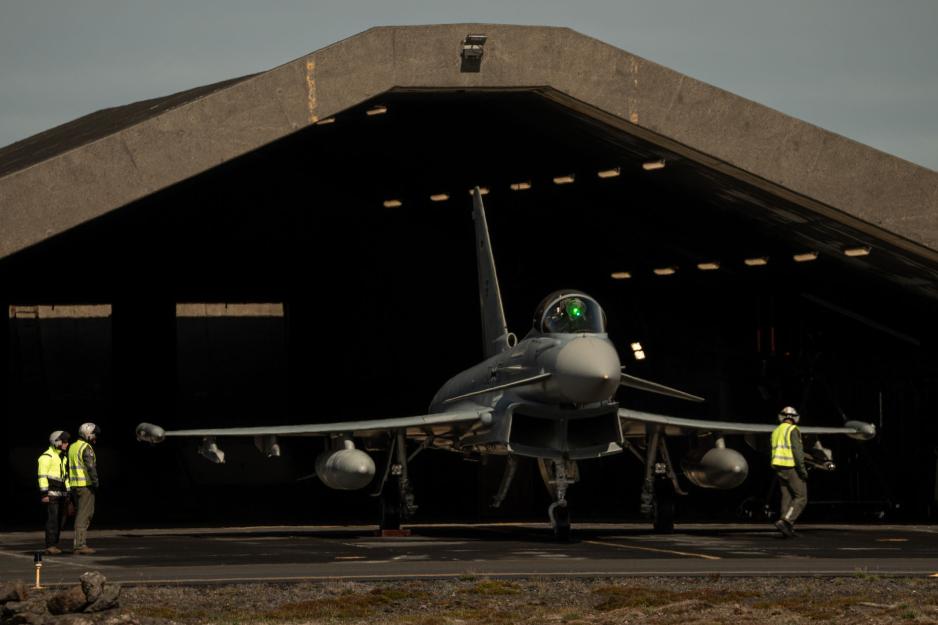
“The deployment of a 30-strong contingent with six Eurofighters to the High North demonstrates Germany’s readiness and ability to swiftly employ an air power capability with lean structures to any location we are needed,” said Lt. Col. Marco Brunhover, Commander of the detachment in question.
“The changed global security situation has had impacts on the High North, and against this background, the German Air Force makes a valuable contribution to Icelandic security and sovereignty and Alliance Deterrence and Defence,” he added.
This deployment supplemented the Iceland Air Policing and enabled the deepening of an already growing German-Icelandic defense cooperation, the Icelandic government maintained.
German fighter jets have operated in Iceland twice before – in 2010 and 2012.
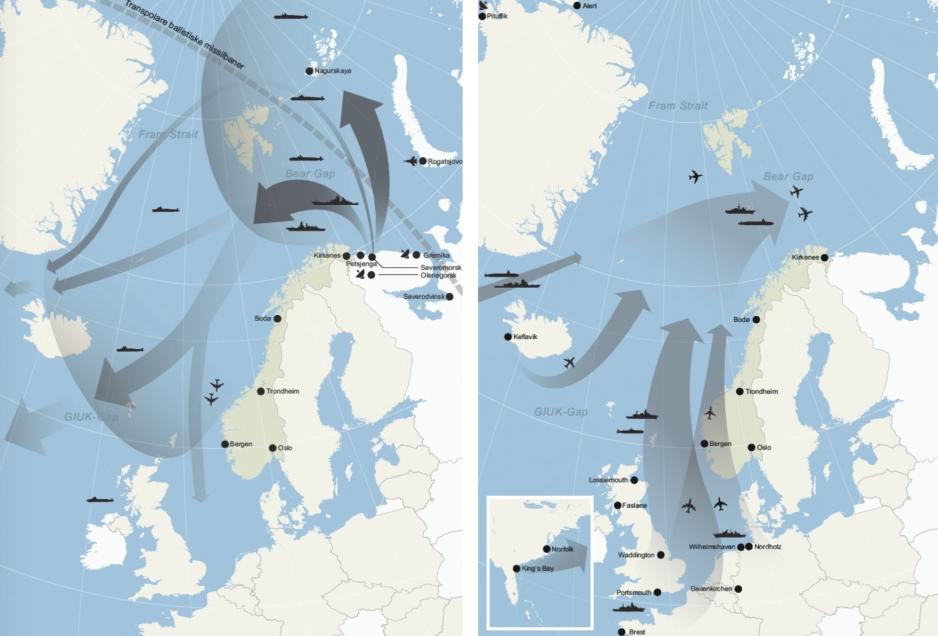
Russian air activity
Russian bombers and fighters have, unsurprisingly, also trained in the north in the same time period as the German and American forces have operated out of Iceland.
In mid-August, two bomber sorties were carried out in Arctic air space, according to the Russian Ministry of Defense:
On 14 August, missile-carrying strategic bombers of the Tu-160 and Tu-95MS types, as well as Tu-22M3 long-range bombers, carried out flights in several places in the Arctic.
Specifically, these aircraft are to have operated over neutral waters in the Barents Sea, the Norwegian Sea, the Arctic Ocean – including the East Siberian Sea, the Chukchi Sea (marginal sea to the Arctic Ocean), and the Beaufort Sea.
The bombers were escorted by fighters of the types Su-35, Su-27, and MiG-31, with support from maritime aircraft. The longest flight is said to have lasted for over seven hours.
A few days before, on 10 August, two Tu-160s carried out a sortie over neutral waters in the Barents Sea and the Arctic Ocean. They were escorted by Su-35 fighters.PreviousNext
“All flights are carried out in strict accordance with international rules for the use of airspace,” says Lieutenant General Sergej Kobylash, Russia’s Long-Range Aviation Commander.
The flights are also referred to as planned and regular in the Arctic, among other regions.
Earlier this year, the Russian Ministry of Defense reported the following bombing sorties within the Northern Fleet military district in northwestern Russia:
- 5 June: Tu-95MS flew over the Barents Sea and the Norwegian Sea for around five hours, escorted by MiG-31 fighters.
- 25 April: Tu-160 strategic bombers, three MiG-31 fighters and two Il-78 tankers carried out a 14-hour flight over the Barents Sea and the Norwegian Sea.
- 14 April: An unknown number of Tu-160s carried out a flight over the Barents Sea and the Norwegian Sea of uncertain duration.
- 14 February: Two Tu-160s flew over the Barents Sea and the Norwegian Sea for around 13 hours.
- January 17: Two Tu-160s conducted a flight over the Arctic Ocean for more than 10 hours.
- The three latter flights probably also included fighter aircraft and possibly also tanker aircraft without it being announced.
It is also relevant that the Northern Fleet’s MiG-31 fighters practiced countering enemy aircraft over the Barents Sea on 23rd of August. The exercise scenario was an air force crossing Russia’s state border in an attempt to carry out missile or bomb attacks on strategic objects. The Russian fighter jets flew out to locate, identify and fight the ‘invaders’.
Keflavík Air Base and Icelandic-US defense cooperation
– The Keflavík air station was built by the US and opened in 1943.
– The US and Iceland entered into a bilateral defense agreement in 1951. It stipulated that the USA would make arrangements for the defense of Iceland on behalf of NATO and granted base rights. After the agreement, Keflavík became a base for American forces.
– At first, the air station was run by the US Air Force. In 1961, it was transferred to the country’s navy and named Naval Air Station Keflavik(NASKEF).
– In 2006, the USA decided that its military presence in Iceland should be significantly reduced – and NASKEF was closed down. That same year, Washington DC and Reykjavik signed an agreement on various conditions surrounding the closing down of the base (including the return of facilities), as well as on future security cooperation to defend Iceland and the North Atlantic region.
– Since then, US forces have not been permanently stationed in Iceland, but Keflavík Air Station (run by the Icelandic Coast Guard) has been used for temporary deployments or short service visits.
– In 2016, the USA and Iceland signed a new joint declaration on security cooperation. This partly deals with American deployments to support the NATO mission of Iceland Air Policing (established in 2009). For this, the US seems to use F-15C fighters primarily.
– In the last four or five years, American strategic bombers of the types B-52, B-1B, and B-2 have operated in Icelandic airspace, but only the latter has been temporarily stationed in Keflavík. The US also uses this air station to deploy P-8A Poseidon maritime patrol aircraft.
– As part of the USA’s ‘European Deterrence Initiative,’ the air station’s facilities were upgraded in 2020.
– The airport in Keflavík has also been important for developing Icelandic commercial aviation. A new terminal for civil traffic opened in 1987. Today, this is Iceland’s largest and only international airport.
Source: High North News



